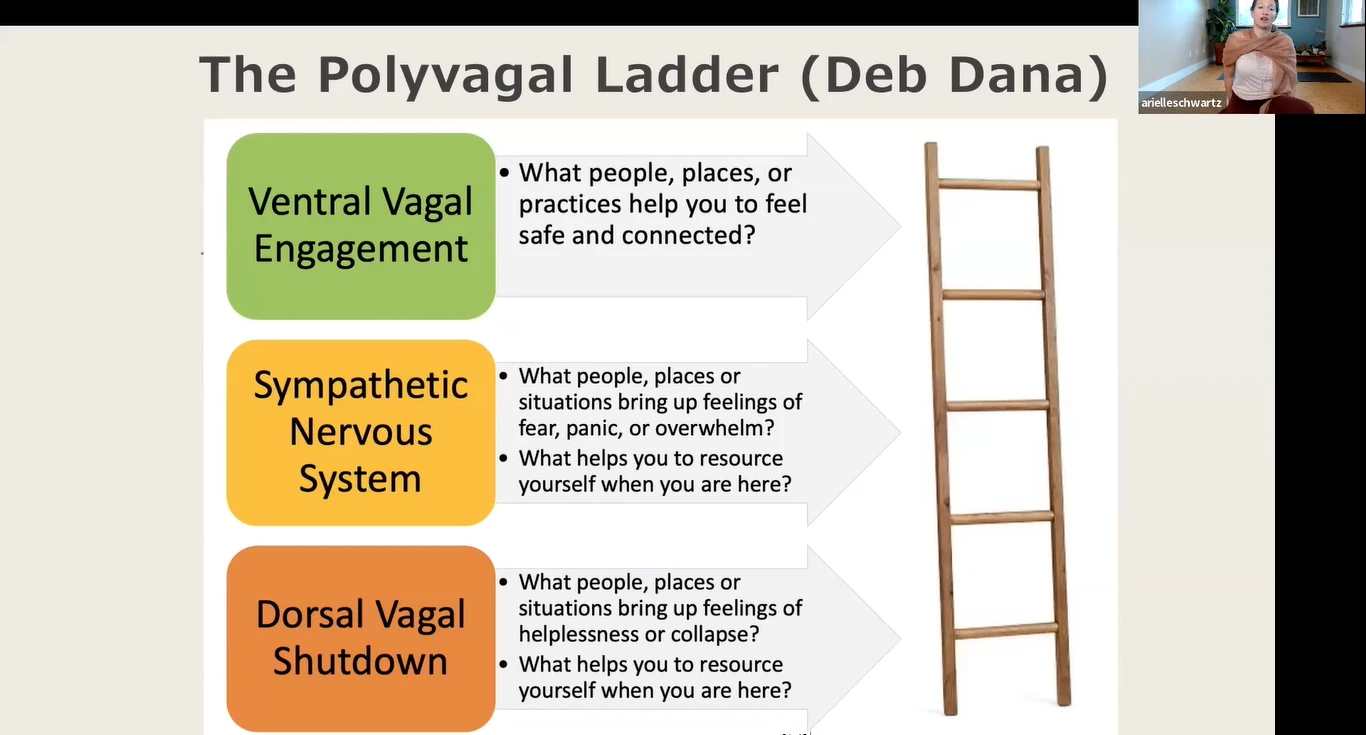How Healthy Is Your Nervous System: Polyvagal Theory Made Simple

Article At A Glance
Looking for ways to help reduce anxiety, stress, and negative reactions to life’s adversities? Ways to improve your nervous system health?
Of course! We all go through periods in life where we wish we had a magic wand to ease the burden of stress and trauma, yes?
Recent studies have revealed the long-term effects of stress and trauma then ever. As a result, we now have some powerful tools at our disposal for reversing the effects of stress and adversity.
In the video below, renowned author Dr. Arielle Schwartz shares one simple tool for determining where we fall on a scale of stress and trauma. Then she shares how to deal with the lingering effects of stress and trauma on our nervous system.
The Polyvagal Ladder: Keys to Finding Your Sweet Spot
The Polyvagal Ladder gives us a tool to determine where we fall on a scale of vagal functioning. Polyvagal Theory describes three modes of nervous system functioning, and how affected we are by trauma, stress, and adversity.
Do you fall in the Green Zone, the Orange Zone, or the Red Zone?
Green is the Go-Ahead Zone: This is the rest-and-digest, relaxed mode of functioning. (For you Yoga Nerds: this is also referred to as the Ventral Vagal Engagement). The Green Zone is our happy, restful, smell-the-roses zone.
Orange Is the Oh-Oh! Zone: This is that frantic, fight-or-flight, hyper mode of functioning. We all fall into this mode when our stress load gets to be too much. Our mind and body go into sympathetic overdrive, and we just can’t seem to relax and let go.
Red Is the High-Risk, Red-Alert Zone: This is the freeze-or-faint zone. Mind and body go into overload, and we begin to shut down physically, mentally, and emotionally. It’s a state of shutdown and dissociation. We may feel brain fog, chronic fatigue, and an inability to connect with the world around us. The red zone is also known as the Dorsal Vagal Shutdown, and it is the system’s ultimate response to extreme trauma.
The good news? Once we are familiar with the three zones of nervous system functioning, we can use techniques to move from the Orange Zone to the Green Zone or the Red Zone toward the Green Zone.
This is what Yoga for Trauma Release is all about. As it turns out, the ancient yogic techniques contain numerous ways to settle the mind and body and induce greater ease and calm in the mind and body.
Moving Up the Polyvagal Ladder: Yoga for Trauma Release
How do we move from the Orange or Red Zone to the Green Zone?
In the video below, Dr. Arielle Schwartz talks about the techniques we can use to alter the state of our nervous system. This allows us move toward a more calm and positive way of functioning. Click below to watch the full video!
Yoga for Trauma Recovery: A Yoga Practice for Enhancing Vagal Tone
Wonder about specific yogic practices for engaging the vagus nerve and inducing a more healthy, Green Zone mode of functioning?
Watch the video below, where Dr. Arielle shares a simple warmup practice to stimulate vagus nerve functioning.
Also, read...
Free Yoga Video: Breathing for Pelvic Floor Health: Two Practices to Deepen Your Breath
May 06 – By: YogaUOnline Staff
How Healthy Is Your Nervous System: Polyvagal Theory Made Simple
Apr 15 – Dr. Arielle Schwartz & Eva Norlyk Smith, Ph.D.
Related courses
Breath as Medicine: Yogic Breathing for Vital Aging
With Doug Keller
Yoga and Myofascial Release: Releasing Chronic Tension with the Bodymind Ballwork Method
With Ellen Saltonstall

Dr. Arielle Schwartz is a psychologist, author, and internationally sought-out yoga teacher, who is known as a leading expert on polyvagal theory. Dr. Arielle is known for her great practical approach to integrating modern polyvagal theory with ancient yogic practices to connect us with our own inner resources for dealing with stress, trauma, and adversity.

Eva Norlyk Smith, Ph.D., is the founder and President of YogaUOnline. She is a lead trainer in YogaUOnline’s Yoga Wellness Educator program, an RYT-300 Yoga Alliance-approved training that focuses on giving teachers the skills they need to offer wellness courses and work with older beginners
Recent articles
4 Ways to Practice Locust Pose
Jun 26 – Baxter Bell, MD, eRYT 500, C-IAYT
The Yoga Sutras: Practicing Non-Attachment without Becoming Detached
Jun 24 – By: Tracy Weber, C-IAYT, E-RYT 500
4 Easy Ways to Use a Sandbag in Yoga Practice
Jun 18 – Jennifer Williams-Fields E-RYT 200
Categories
Upcoming courses
Breath as Medicine: Yogic Breathing for Vital Aging
With Doug Keller
Yoga and Myofascial Release: Releasing Chronic Tension with the Bodymind Ballwork Method
With Ellen Saltonstall
JOIN NOW!
Recent articles
Almost there...
Sorry, we couldn't find anything...
Pose Library
4 Ways to Practice Locust Pose
Locust Pose (Salabhasana) is a simple backbend that strengthens the entire back of your…
Jun 26 – Baxter Bell, MD, eRYT 500, C-IAYT
Beginning Yoga
The Yoga Sutras: Practicing Non-Attachment without Becoming Detached
The concepts of attachment and non-attachment are mentioned several times in The Yoga Sutras…
Jun 24 – By: Tracy Weber, C-IAYT, E-RYT 500
Yoga Practice Tips
4 Easy Ways to Use a Sandbag in Yoga Practice
B.K.S. Iyengar is credited with introducing props into modern yoga as a means of…
Jun 18 – Jennifer Williams-Fields E-RYT 200



